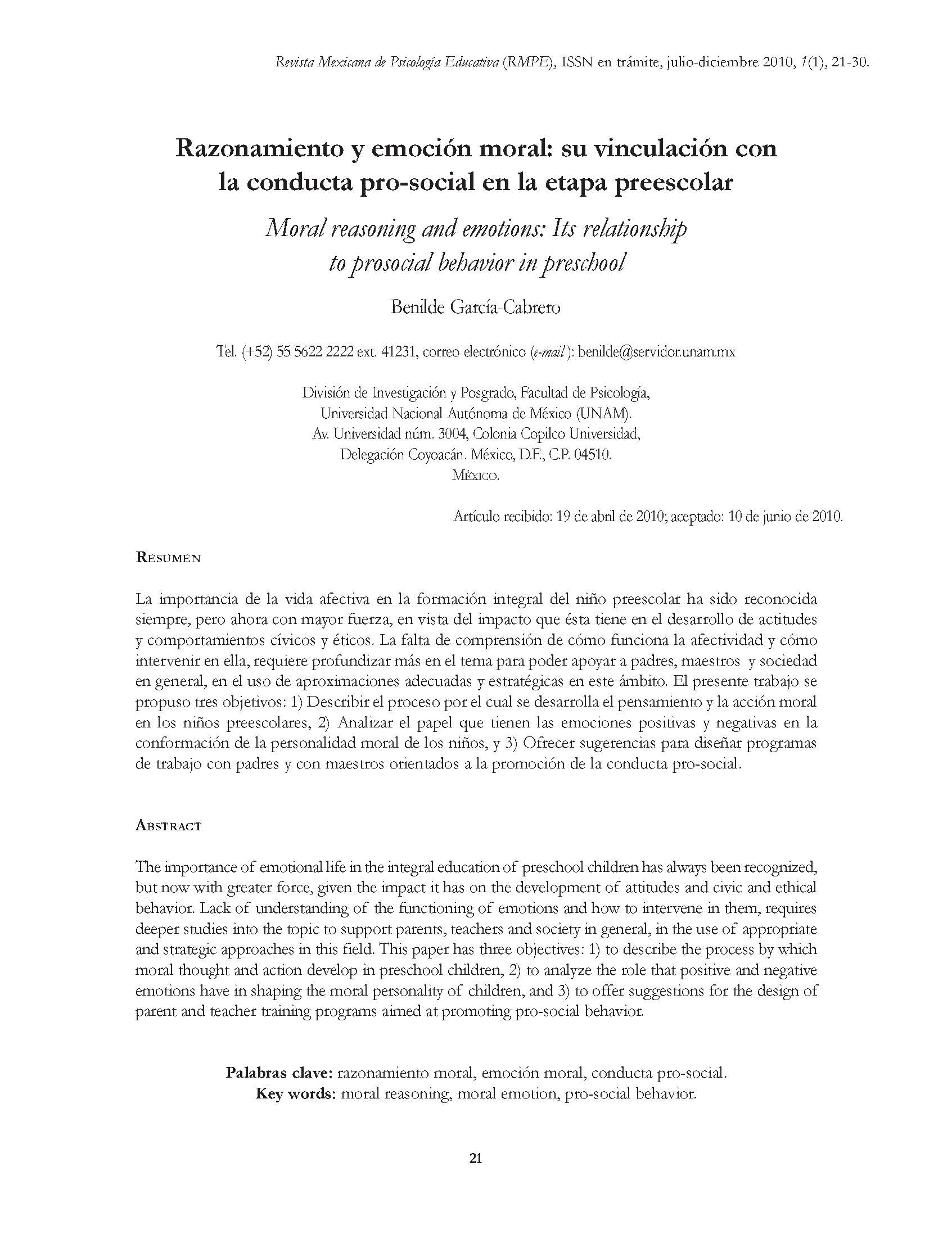Resumen
La importancia de la vida afectiva en la formación integral del niño preescolar ha sido reconocida siempre, pero ahora con mayor fuerza, en vista del impacto que ésta tiene en el desarrollo de actitudes y comportamientos cívicos y éticos. La falta de comprensión de cómo funciona la afectividad y cómo intervenir en ella, requiere profundizar más en el tema para poder apoyar a padres, maestros y sociedad en general, en el uso de aproximaciones adecuadas y estratégicas en este ámbito. El presente trabajo se propuso tres objetivos: 1) Describir el proceso por el cual se desarrolla el pensamiento y la acción moral en los niños preescolares, 2) Analizar el papel que tienen las emociones positivas y negativas en la conformación de la personalidad moral de los niños, y 3) Ofrecer sugerencias para diseñar programas de trabajo con padres y con maestros orientados a la promoción de la conducta pro-social.
Citas
Araujo, V. A. y Sastre, V. G. (2003). Moralidad, senti- mientos, y educación. Educar, 31, 47-66.
Arsenio, W. (1988). Children’s conceptions of the situational affective consequences of victimization. Child Development, 59, 1611-1622.
Borke, H. (1971). Interpersonal perception of young children: egocentrism or empathy? Developmental Psychology, 38, 469-479.
Bronson, M. B. (2000). Self-regulation in early childhood.
Nueva York: Guilford Press.
Colby, A., Ehrlich, T., Beaumont, E. y Stephen, J. (2003). Educating citizens: Preparing america's underg- raduates for lives of moral and civic responsibility. San Francisco: Jossey-Bass.
Dunn, J. (1987). The beginnings of moral understanding: Developments in the second year. En J. Kagan y S. Lamb (Eds.), The emergence of morality (pp. 91-112). Chicago: University of Chicago Press.
Edelstein, W. (2005). The rise of right-wing extremist youth culture un post-unification Germany. En:
L. Nucci (Ed.), Conflict, contradiction, and contrarian elements in moral development and education (pp. 157- 172). Mahwah, Nueva Jersey: Lawrence Erlbaum Associates Publishers.
Emde, R., Johnson, W.F. y Easterbrooks, M.A. (1987).The Do’s and Don’ts of early moral devel- opment: Psychoanalytic tradition and current research. En J. Kagan, y S. Lamb (Eds.), The emergence of morality in young children (pp. 245-276). Chicago: University of Chicago Press.
García-Cabrero, B. y Eguía, S. (2006). El razonamiento y la afectividad moral: componentes esenciales de la educación moral y cívica. Revista Educación 2001, 132, 37-45.
García-Cabrero, B. y Flores, R. C. (1998). El desarrollo de programas de vinculación escuela-hogar. Integración: Educación y Desarrollo Psicológico, 10, 36-50.
Gardner, H. (2001). Inteligencias múltiples (La teoría en la práctica). Barcelona: Paidós.
Gelman, R. (1979). Preschool thought. American Psychologist, 34, 900-905.
Haidt, J. (2003). The moral emotions. En R. J. Davidson, K. R. Scherer y H. H. Goldsmith (Eds.), Handbook of affective sciences (pp. 852-870). Oxford: Oxford University Press.
Hoffman, M. L. (1987). The contribution of empathy to justice and moral judgment. En N. Eisenberg y
J. Strayer (Eds.), Empathy and its development. New York: Cambridge University Press.
Hong, Y. (2003). An Ethnographic Study of Korean Kindergartners' Reasoning During Group Moral Discussions. Early Childhood Education Journal, 30(3), 151-156.
Jagers, R. J. (2005). Moral competence promotion among African American children: conceptual under- pinnings and programmatic efforts. En: L. Nucci (Ed.), Conflict, contradiction and contrarian elements in moral development and education (193-212). Mahwah, New Jersey: Lawrence Erlabaum Associates Publishers. Kagan, J. (1981). The second year. The emergency for self- awareness. Cambridge, MA: Harvard University
Press.
Kohlberg, L. (1992). Psicología del desarrollo moral. Bilbao: Desclée de Brouwer.
Nucci, L. (2001). Education in the moral domain.
Cambridge: Cambridge University Press.
Onn, J. (1998). Civics and moral education in Singapore: Lessons for citizenship education?, Journal of Moral Education, 27(4), 505-524.
Oser, F. K. (2005). Negative morality and the goals of moral education. En L. Nucci (Ed.), Conflict, contradiction, and contrarian elements in moral development and education (pp. 129-153). Mahwah, Nueva Jersey: Lawrence Erlbaum Associates Publishers.
Oser, F. K. y Veugelers, W. (2003). Teaching in moral and democratic education. Bern: Peter Lang.
Perner, J. (1991). Understanding the representational mind.
Cambridge, MA: MIT Press.
Piaget, J. (1932). The moral judgment of the child. Londres: Rout- ledge. Traducido al español (1977) por Ed. Fontanella, Barcelona bajo el título: El criterio moral del niño.
Piaget, J. (1981). Intelligence and affectivity: their relationship during child development. Palo Alto, California: Annual Reviews. Puig, J. M. (1995). La educación moral en la enseñanza obligatoria. Cuadernos de Educación, Número 17. Barcelona: Horsori.
Puig, J. M. (1996). La construcción de la personalidad moral.
Barcelona: Paidós.
Scheler, M. (1996). Ordo amoris. Madrid: Caparrós.
SEP (2004). Programa de Educación Preescolar. México: SEP. Disponible en: http://www.oei.es/ inicial/curriculum/programa2004_mexico.pdf
Sy, S. R., DeMeis, D. K. y Scheinfield, R. E. (2003). Pre- school children’s understanding of the emotional consequences for failures to act prosocially. British Journal of Developmental Psychology, 21, 259-272.
Walsh, J. D. (1992). Implications of a post-Piagetian perspective for early childhood education: Helping children make sense. Ponencia invitada al Taipei Municipal Early Childhood Education. Taipei, China

Esta obra está bajo una licencia internacional Creative Commons Atribución-NoComercial-SinDerivadas 4.0.
Derechos de autor 2024 Universidad Nacional Autónoma de México


